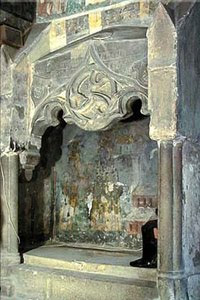The Bistriţa River is crossing down this reserve on a length of ca. 2 km, making there those gorges relief type. The nature reserve is located on the northern slope of Pietrosul Bistriţei summit (made of gneiss) and on the southern slope of Rarău-Giumalău massif (made of limestone and crystalline schist, belonging to the Jurassic age). According to Koppen, that region has a boreal climate (type Df), with cold, wet winters, and unstable and chilly summers. The average temperature is +4.2 OC per year. The most frequent winds are those from the west (31.7%), while those from the east have a frequency of 9.4%. Those western winds raise the degree of soil humidity by their raining contributions. One can remark the fact that along the Bistriţa river, the winds have a smaller intensity, being channelized by the passage of that valley.
Photo by Emilian Pricop
Wilderness of rocks, flora, scenic beauty, make this area a sight of great interest. The first mentions over the flora of that region have been made by D. Brândza (1889); later on, D. Grecescu (1898), A. Procopianu-Procopovici (1906) made other mentions. The Queen flower is found here in the lowest area in the country and is a natural monument, is found here in the lowest state in the country. Also here was detected the presence of endemism Pietrosia levitomentosa (syn. Andvyala levitomentosa), housed in an inaccessible area (on Pietrosul Bogolin summit, at ca. 1750 m.s.l.).
- Can be seen here Carpathian endemites (in general): Aconitum moldavicum ssp. hosteanum, Campanula rotundifolia ssp. polymorpha, Cardamine glanduligera, Festuca carpatica, Symphytum cordatum, Leucanthemum waldsteinii, Melampyrum saxosum, Poa rehmannii, Campanula carpatica, Phyteuma vagneri;
- Romanian Carpathian endemites: Aconitum moldavicum ssp. moldavicum, Scabiosa lucida ssp. barbata, Silene nutans ssp. dubia, Dianthus tenuifolius, Eritrichium nanum ssp. jankae, Thymus bihoriensis;
- Eastern & Southern Carpathian endemites: Gentiana cruciata ssp. phlogifolia, Primula elatior ssp. leucophylla, Ranunculus carpaticus, Hepatica transsilvanica.
- Some plant species into the natural reserve of "Zugreni Gorges" are pretty rare, such as: Matteuccia struthiopteris, Pinus mugo, Arnica montana, Avenula compressa, Corrallorhiza trijida, Doronicum columnae, Elsholtzia ciliata, Epipogium aphyllum, Ligusticum mutellina, Lilium martagon, Rhodiola rosea, Telekia speciosa, Euonymus nana, Leontopodium alpinum (this last one is situated at only 740 m.s.1. there).
Zugreni is one of the most beautiful and exciting areas of Romania, very popular for spending active holidays or free time (fishing, trekking, hiking, rafting).

























